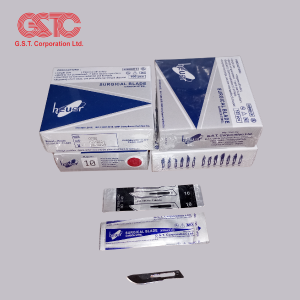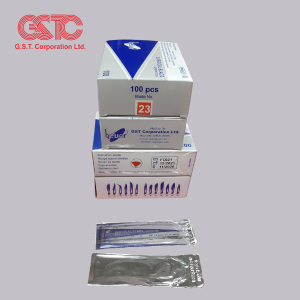Introduction to Surgical Blades
Surgical blades are surgical instruments used in the medical profession, especially for cutting the skin and tissues in surgeries and other medical procedures. Knowing the many types of surgical blades will help you use them optimally enhancing surgical accuracy and improving post-operative results. This page examines all facets of the types of surgical blades including their respective uses and characteristics in each case.
Types of Surgical Blades Based On Sizes
Surgical blades come in various shapes and sizes, each designed for specific tasks. We will go through the different types of surgical blades and their unique features.
1) Surgical Blade 10
Surgical blade 10 is the most popular surgical blade. Used in many surgeries, the surgical blade is very broad and curved. This makes it an ideal tool to be used for incising skin and muscles. This blade can be applied to small, medium, or major surgeries.
2) Surgical Blade 11
11 Number Blade has a blunt edge that allows smooth cuttings along soft tissues. It is used in surgical operations that involve delicate parts, such as lesion removal or removal of excess tissue. Its design allows for very low trauma to the tissues adjacent to it, thus making the recovery easier.

3) Surgical Blade 12
12 Number Blade has a curved edge that facilitates smooth cutting along soft tissues. This blade is used in surgical procedures involving delicate areas, such as removing lesions or excess tissue. Its design promotes minimal trauma to surrounding tissues, enhancing recovery.
4) Surgical Blade 15
Surgical blade 15 has a dull edge because of its intended use in cutting deep inside. They are used in places where multiple incision cuts are needed; for example, abdominal surgeries. Their edges allow cutting with minimal resistance and hence do not tear the tissues, healing faster.
5) Surgical Blade 18
Surgical Blade 18 is a small, curved blade with a rounded tip, great for making precise cuts in delicate surgeries. It’s commonly used for dissection, cutting soft tissues, and working near blood vessels. Made from stainless steel, it’s sharp, durable, and doesn’t rust, but needs to be handled carefully.
6) Surgical Blade 20
Surgery Knife 20 is a surgical knife, with a curved-edge design, that makes cutting smooth and easy during surgery. Such parts need delicate maneuvers while operating, which requires this kind of surgery knife. All of these blades are made from either stainless steel or high-carbon steel, and thus, they are strong and sharp. Its design has made it ergonomic to handle, thus allowing surgeons to be well expansive in the handling of complex tasks. It is also provided in a pre-sterilized package with all the necessary packaging for their instant use and thus hygiene and safety in the medical health facilities are ensured.
7) Surgical Blade 21
The Surgical Blade 21 contains a larger and somewhat curved edge. This makes it applicable to numerous surgery procedures especially in cutting the skin and suturing. This blade is known to be preferred by experts due to its balance and control for very clean cutting without much trauma of tissues around it. Generally, its construction is made of high-quality stainless steel. Thus it is longer lasting and holds sharpness. Being compatible with a standard scalpel handle it also ensures versatility. As with other blades, this also is available for sterilization as applicable. However, when “medical supplies” are considered it also has availability in bulk packaging.
8) Surgical Blade 22
Surgical Blade 22 is defined as a slender-bladed surgical blade with a pointed tip since this type of surgical blade is highly important to make detailed dissections and precise incisions in surgical procedures. The shape allows surgeons to pass through complex anatomical structures efficiently, hence highly useful for surgical specialists. Besides, it was only made from high-quality stainless steel materials to provide excellent sharpness and strength. The ergonomic design of the blade makes it easy to grip and maneuver for healthcare professionals to operate with confidence and accuracy. It is usually in sterile packs; thus, meeting the high hygiene standards of the medical profession.
9) Surgical Blade 23
Surgical Blade 23 is a very versatile product that is usually applied in surgical procedures, plus, with such sharpness, they get the job done. The blade has a sharply curved edge, which facilitates incisions in both the superficial and deeper tissues. The blade is made of high-quality carbon steel or stainless steel to be long-lasting, sharp, and precise. The design allows for excellent control during use and is thus appropriate for the surgery specialties. It is sold mainly in sterilized packs, adhering to rigid safety standards, thus offering healthcare professionals a very reliable tool for their surgical procedures.

10) Stainless Steel Surgical Blade
These blades don’t wear out or rust easily. They are safe for the body and stay sharp for a long time, making them ideal for general surgical procedures.
11) Carbon Steel Surgical Blade
Made from iron and carbon, these blades are very sharp and strong. They don’t rust easily but need to be stored carefully. They are good for precise surgeries like dissection.
12) High Carbon Steel Surgical Blade
These blades have more carbon, making them sharper and stronger. They stay sharp longer but can rust, so they need proper care. Making them ideal for advanced surgeries requiring precision.
13) Sterile Surgical Blade
Sterile surgical blades are packaged in such ways that they remain non-contaminated. This is necessary to eliminate the possibility of infection during surgery. It comes in different sizes and types to suit the surgeon’s needs for accomplishing all sorts of surgery procedures safely.
Scalpel Handle
Though a scalpel handle is not a blade, it acts as a holding and manipulating tool to perform surgical blades. Scalpel handles exist for different types of surgical blades making it convenient to change the blades which ultimately ensures perfect control during the surgery. The right choice of scalpel handle may prove to be the difference between cumbersome instrumentation or surgery on target.
Types of Surgical Procedures:
Surgeons require different surgical instruments during various kinds of surgeries. For successful surgery, selecting the right tool is vital as different surgeries require specific blade types tailored to the task. For example, delicate procedures like ophthalmic surgery may require finer blades, while larger incisions in abdominal surgeries might require broader, sturdier blades.
Here’s a more detailed exploration of how the type of procedure influences blade selection:
1) Delicate Procedures
-
Ophthalmic Surgery:
The surgical process related to the eyes is known as Ophthalmic Surgery such as Cataract Operation etc. In these procedures, surgeons require blades that offer exceptional precision and control. Finer blades, often called ophthalmic knives, are designed for making minute incisions with minimal tissue disruption.
-
Plastic Surgery:
Even surgical procedures like face lifting or reconstructive surgery demand a lot of accuracy. Surgical knives used in such surgical procedures can even draw clean cutting lines with the least scars on body parts that would further aim at providing an improved cosmetic result.
2) General Surgery
-
Abdominal Surgeries:
When incisions are large, for example in appendectomies and laparotomies, then the blades have to be bigger and stronger. Those will do nicely for making cuts through thicker skin and muscles to obtain a good clean cut easily and in control. Commonly, these are surgical blade sizes such as No. 10 or No. 15, as they tend to make longer clean cuts.
-
Laparoscopic Procedures:
Specialized instruments with blades specific to certain specialties, designed for the use of trocars and cannulas during minimally invasive surgery, causing minimal trauma to tissues while still performing delicate incisions.
3) Specialized Surgery
-
Orthopedic Surgery:
Blades used in orthopedic procedures need to be robust and able to penetrate through denser tissues and bone. Here, heavy-duty surgical blades or chisels may be employed to achieve the necessary depth and stability during incisions.
-
Cardiothoracic Surgery:
In procedures involving the heart or lungs, blade selection can greatly impact access to the thoracic cavity. Blades must be able to navigate through layers of skin, fat, and muscle while minimizing trauma to vital organs.
-
Consideration of Incision Types:
The type of incision planned — whether horizontal, vertical, or oblique, also influences the blade choice. Each incision type may benefit from specific blade designs that facilitate ease of use and reduce recovery time.
Understanding the specific requirements of each surgical procedure is crucial for selecting the appropriate blade. By aligning the blade type with the surgical task at hand, surgeons can enhance their effectiveness, improve patient outcomes, and ensure safer surgical practices.
Choosing the Right Types of Surgical Blades
An appropriate surgical blade is necessary as it ensures the desired surgical outcome. An informed choice can minimize tissue damage and promote faster recovery for patients. To resolve this issue we have discussed in detail about different types of surgical blades and their uses.
Here are key factors to consider when choosing a surgical blade:
-
Patient’s Condition:
Patients with sensitive or delicate tissues may benefit from sharper blades that reduce trauma and if we have patients with tough tissue types may benefit from more robust blades that can handle increased resistance without compromising effectiveness.
-
Surgeon’s Preference:
The familiarity with and comfort with using specific blade types raises performance and confidence in surgery by the surgeon. This is variable as it depends on previous experiences as well as training and personal handling styles. Health institutions need to make sure surgeons are allowed to handle the blades they are most comfortable with.
-
Types of Surgical Blades Based On Material Composition
The material of the different types of surgical blades or operational blades differs in carbon steel, and stainless steel, which is sharper, tougher, and less expensive than the other.
* Stainless Steel
These blades do not rust, but they are rather very hard and take a long to lose their sharpness.
* Carbon Steel
These blades are available that give precision and sharpness and can be afforded very cheaply for disposable scalpels.
* High Carbon Stainless Steel
It involves the sharpness of carbon steel and the rust resistance of stainless steel. It is used in complicated surgeries.
-
Sterility Requirements:
It is important to keep the blades as sterile as possible to avoid surgical site infections. The nature of the procedure and the risks of contamination would determine whether to use single-use sterile blades or re-sterilizable blades.
-
Cost Considerations:
While cost should not compromise patient safety, budget does come into play when choosing different types of Operational blades. Facilities must weigh the long-term benefits of investing in better blades rather than cheaper blades that may not have comparable performance potential or durability.
-
Environmental Factors:
Sustainability is becoming more important in medical practices as the increase in deforestation and pollution is the main cause of the rapid increase in the number of diseases. Surgeons and other medical practitioners should consider the environmental impact of disposable blades versus reusable options and should follow eco-friendly practices.
Understanding these factors will guide healthcare professionals in choosing the right surgical blade for each procedure.
For Further Queries – Visit our Surgical Blades Product Page
Conclusion
Scalpel blades are essential tools used in medical practices whenever any surgical procedure is considered. The surgeon needs to know about different types surgical blades and their uses. Each blade is designed to meet specific requirements enhanced by time. In this blog, we have discussed a limited number of surgical instruments, but surgeons are expected to have a comprehensive understanding, and their knowledge should not be limited to blade 11, blade 12, and others. This knowledge enables surgeons to make better choices for selecting different types of surgical blades. The outcome of surgery depends not only on the surgeon but also on the appropriate surgical blades.